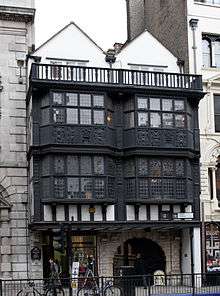Prince Henry's Room
Prince Henry's Room is situated on the first floor at the front of No. 17 Fleet Street, London. The house is one of the few surviving buildings in the City of London dating from before the Great Fire of London in 1666. It is a Grade II* Listed Building.[1]

History
The site was once owned by the Templars, but after the dissolution of the Order of St John, the building was rebuilt in 1610 and became a tavern called Prince's Arms. This coincided with the investiture of Prince Henry, son of James I, as Prince of Wales. During the 17th century, the house was known as the Fountain Inn and was visited by Samuel Pepys on 14 October 1661. He wrote "In the afternoon Captain Ferrers and I walked abroad to several places; among others, to Mr. Pim's my Lord's tailors and there he went out with us to the Fountain tavern and did give us store of wine." On 28 November 1661, Pepys wrote "to the Fountain tavern and there stayed till 12 at night, drinking and singing, Mr. Symons and one Mr. Agar singing very well. Then Mr. Gauden, being almost drunk, had the wit to be gone; and so I took leave too" During the early 19th century a famous exhibition "Mrs Salmon's Waxworks" was held in the front part of the house, whilst the tavern continued in the rear. The house became the property of the London County Council in 1900[2] with the aid of a contribution from the City of London Corporation.[3] It later passed to the City of London Corporation, which administers the property now.
It is currently only viewable when special events are held there, and the City of London Corporation has recently completed a consultation with interested parties regarding the room's usage. The main feature is the fine and rare highly decorated Jacobean plaster ceiling, with the Prince of Wales's feathers and the initials "PH" in the centre. There is one wall of original Jacobean wood panelling left; the other panelling is Georgian. The unexceptional fireplace has a wood surround and panelling above, with an inscription above recording the connection with the diarist and great naval administrator, Samuel Pepys. There are also fine leaded lights with coats of arms and badges, best seen from within the room.
From 1975, the room was a museum which hosted a Samuel Pepys exhibition — Pepys was born in Fleet Street in 1633. The Samuel Pepys Club financed much of the original 1975 exhibition. The museum was closed to the public after a decade or so and is now empty of all furniture save for a large table.
In the late 18th century it was a coffee house called Nando's. Lord Thurlow frequented the place before he went on to practise law in the 1770s. It later became a hairdressers and a plaque used to state it was once the home or palace of Henry the VIII also Cardinal Wolsey lived there. The enriched ceiling was plastered with a"P" triple plumed. Once the Management of the Duchy of Cornwall held their sittings here in the time of Charles I, on or about 1619 (see Mrs Green's "Calendar of State Papers").[4]
References
- Historic England. "Details from listed building database (1064693)". National Heritage List for England. Retrieved 28 September 2015.
- "Prince Henry's Room". City of London. Archived from the original on 1 April 2016. Retrieved 22 June 2016.
- Gibbon and Bell, History of the London County Council, 1889–1939 (London: Macmillan & Co., 1939), p. 484
- John Timbs; Clubs and Club Life In London. 1872
- The London Encyclopaedia p. 639, Ben Weinreb & Christopher Hibbert, Macmillan, 1995, ISBN 0-333-57688-8